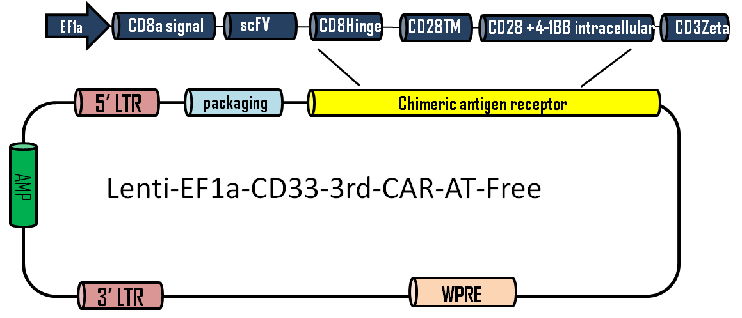Lenti-EF1a-CD33-3rd-CAR-AT-Free
CD33 is a type I transmembrane receptor protein composed of 364 amino acids with a molecular weight of 67kDa. Its N-terminus is located outside the cell, and the terminal amino acids form a conserved V-set immunoglobulin-like domain and a variable C2-set domain, where V-set specifically recognizes and binds to sialic acid; cytoplasmic tail end There is an immunoreceptor tyrosine inhibitory motif and an ITIM-like structure, which can be combined with tyrosine phosphatase to deliver inhibitory signals to the cell, thereby achieving the purpose of regulating cell growth. When CD33 is expressed on the surface of the cell membrane, it can act as a sialic acid-dependent cell adhesion factor, and then play a role in regulating the proliferation and differentiation of target cells. The CD33 molecule has a flexible domain that can be combined with a variety of molecular structures. Its ability to mediate intermolecular interactions depends on the differentiation stage of hematopoietic cells, and this ability can be regulated by endogenous complex disaccharides. CD33 is expressed on the surface of normal and leukemic lymphocytes, and there is no single expression in hematopoietic cell subsets in hematopoietic stem cells. This expression continues along the differentiation of bone marrow monocytes, until the granulocyte stage is known to be inhibited, but it still exists in monocytes and microphages. Studies have also shown that certain subsets of human T cells and NK cells activated by mitogens and heterotypic antigens express CD33 at both protein and nucleic acid levels. CD33 is expressed in 90% of myeloid leukemia cells. Although it is also expressed in myeloid hematopoietic progenitor cells, it is not expressed in normal hematopoietic stem cells. Studies have shown that the hematopoietic function can be restored after removing CD33 positive cells in vitro. Therefore, CD33 has become an ideal target in the early stage of AML, and CAR-T cells targeting CD33 may also become a reality in clinical practice. This product is a third-generation lentiviral expression vector targeting CD33.
Product name: Lenti-EF1a-CD33-3rd-CAR
Promoter: EF1a [1]
Co-activation of intracellular signaling: of CD28 / 4- . 1 BB / CD3Zata
Resistance gene: Amp

Remarks:
Compared with the CMV promoter, EF1a can be continuously expressed in immune cells, so it can significantly extend the expression of CAR in T cells.

